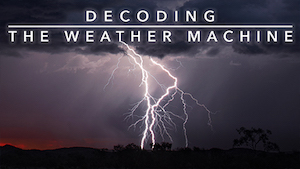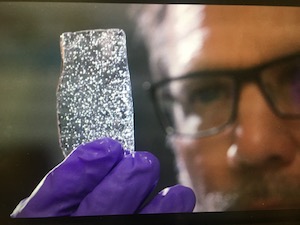 One of the hardest lessons I have had to learn is that facts are not all powerful. As a scientist, I love facts. A paleontologist tells me that there is a 365-million-year-old fishlike thing with eight fingers that is an ancient cousin to tetrapods? Amazing! Where can we find more like it? A climate scientist tells me that carbon dioxide levels in the atmosphere are at their highest levels in the last 800,000 years and we are already in the midst of global climate changes? Terrible! What do we do about it?
One of the hardest lessons I have had to learn is that facts are not all powerful. As a scientist, I love facts. A paleontologist tells me that there is a 365-million-year-old fishlike thing with eight fingers that is an ancient cousin to tetrapods? Amazing! Where can we find more like it? A climate scientist tells me that carbon dioxide levels in the atmosphere are at their highest levels in the last 800,000 years and we are already in the midst of global climate changes? Terrible! What do we do about it?
In working with NCSE, though, I’ve come to understand that sometimes the facts are not enough. It’s not that they aren’t important, but that they require some pre-work to well, work. There are treatises written on why this is, but the short answer is that it has to do with trust. When your facts are threatening to a person’s worldview, whether religious or economic or political, there has to be trust for the message to get through.
There are a number of ways to build trust, including being mindful of the messenger. I love me some Al Gore and respect him immensely, but where I see a person who has been at this longer than most, others may see a cranky politician with an axe to grind. What if the messenger isn’t Al Gore, though, but your local meteorologist? Would more people listen? And what if instead of just stating the facts and showing the graphs, you instead show the scientists in the process of collecting and analyzing the data? Would that help to get the message across?
NOVA hopes so.
Science As Process
In their new two-hour special Decoding the Weather Machine, NOVA uses a variety of voices to walk the viewer through the science—not just science as facts, but science as process. We start with Paul Douglas, a Minnesota meteorologist who used to be skeptical of climate change. He explains that his conservative worldview was at the root of his doubt: “If [climate change] is true, then the only possible solution is more government, more regulation, EPA times 100.” But, he tells us that through his years reporting on the weather, it became clear that something was “up” with the weather, and that “it isn’t just the weather that’s changing. It’s what’s driving the climate.”
 From there, NOVA takes us on a journey to the end of the eighteenth century, when scientists worked out how greenhouse gases are responsible for making Earth a habitable planet. From there we go to Mauna Loa observatory where Ralph Keeling is carrying on a family tradition of collecting real-time CO2 data, to Antarctica, where Ed Brook explains how we bubbles trapped in ice give us direct windows to the past, allowing us to extend the Mauna Loa record back 800,000 years. Andrea Dutton explains how careful analysis of carbon isotopes in fossils let her extend the record back further—much further.She can take a 50-million-year-old clam shell and “tell you the summer and winter temps in a single year.” The program bounces back and forth among these voices, as each building on the one before. The scientists tell you about their data in an accessible way, without condescension. We learn how to determine whether carbon dioxide has a “natural” source, such as a volcano, or an “un-natural” one like, a car’s combustion engine. Guess which category most of the last two century’s of emissions fall into?
From there, NOVA takes us on a journey to the end of the eighteenth century, when scientists worked out how greenhouse gases are responsible for making Earth a habitable planet. From there we go to Mauna Loa observatory where Ralph Keeling is carrying on a family tradition of collecting real-time CO2 data, to Antarctica, where Ed Brook explains how we bubbles trapped in ice give us direct windows to the past, allowing us to extend the Mauna Loa record back 800,000 years. Andrea Dutton explains how careful analysis of carbon isotopes in fossils let her extend the record back further—much further.She can take a 50-million-year-old clam shell and “tell you the summer and winter temps in a single year.” The program bounces back and forth among these voices, as each building on the one before. The scientists tell you about their data in an accessible way, without condescension. We learn how to determine whether carbon dioxide has a “natural” source, such as a volcano, or an “un-natural” one like, a car’s combustion engine. Guess which category most of the last two century’s of emissions fall into?
Once the compelling and convincing case for climate change has been laid out, the second third of the special focuses on building understanding of what NOVA is calling “the climate machine.”
I want to pause here to express my only real criticism of the program—its title. Why is it called Decoding the Weather Machine and not Decoding the Climate Machine? I think that was a mistake. The special obviously talks a lot about weather because weather is what we experience day to day, but it’s not about weather—it’s about climate. Using “weather” instead of “climate” in the title poses a risk that potential viewers interested in climate change won’t tune in because they think it’s a NOVA special about severe weather without a larger context. Not to mention, the special talks about “the climate machine” not “the weather machine” so it feels like an odd and clumsy choice.
The Climate Machine
Back to the program: The climate machine has four inter-related parts: Earth, atmosphere, ocean, and ice. We learn that trees have soaked up 25% of the CO2 we have emitted, and that oceans have absorbed another 25%.Oceans have absorbed so much heat, we learn, that if the atmosphere had to do it, it would have resulted in 20°F of warming. But because of the properties of water, that absorption has resulted in “just” 0.5°F of ocean temperature rise. This relatively small amount of warming has not, of course, been without consequences (just ask the coral reefs), but the worst possible effects have so far been avoided. How long can our luck last?
This is where things got scary. We learn that there are 23’ of sea level rise tied up in the Greenland glacier, and 200’ in Antarctica. These numbers feel preposterous and I admit I found myself thinking, “that can’t happen.” The NOVA producers anticipated that reaction, and we are taken to Australia where Andrea Dutton explains, “Earth has done experiments in the past for us” and that by analyzing sediments and correlating them with what we know about past temperatures, the amount of warming we have already experienced has in the past led to 20–30’ sea-level increases. The only reason we haven’t experienced that today is because our ice sheets have held.
At this point, I felt myself shutting down. It was too much, I can’t worry about that. The NOVA special counters the very human reaction to wish the problem away by introducing us to a child living in Norfolk Virginia and a poet living in the Marshall Islands—they are already living it. The poet, Kathy Jetñil-Kijiner, says, “It’s kind of hard to connect with an issue that you don’t see outside your own front door. I understand that. It doesn’t stop it from becoming a reality though.”
Three Options
So what do we do? In the final third of the program, our three options are introduced: 1) do nothing and suffer the consequences; 2) adapt; 3) mitigate. The more we adapt and mitigate, the less we suffer. The more we mitigate, the less we will have to adapt. We are introduced to individuals working on mitigation and adaptation on a variety of scales. We get a much-needed jolt of optimism from researchers at the National Renewable Energy Lab outside Denver, CO, who are working on moonshot solutions like algae-based fuels and a bonkers-sounding material called perovskites that have the potential to let us turn everything from our clothes to our roadways into solar-harnessing machines.
The solution-oriented voices are soothing, but we are brought back to reality as the NOVA special winds up for its big finish. “One powerful piece of the climate machine so unpredictable and inconsistent that no computer could ever guess how it will behave: Us.” And here we are, back where we started.
“Up to 2008 there was bipartisan support for climate action,” meteorologist Douglas reminds us, “but now it’s a political football and that’s unfortunate because republicans’ homes are going to flood just as readily as democrats’. We need to get past denial and we need to find some common ground. We can debate policy, but let’s not debate the facts.”
Efforts like this NOVA special will help us to move beyond debates about facts by providing a blueprint for reaching out to those that are hardest to reach. I am not naïve enough to think that everyone watches PBS with the same zeal that I do, but I can hope that those of use who are in the business of communicating climate science can follow its example of using diverse voices, telling human stories, and providing opportunities to engage with the evidence.
Do I wish that everyone trusted science and scientists like I do? Of course, but that isn’t reality. To get us there, we have to work on building the trust and those that worked on this NOVA special have clearly internalized the lesson that took me so long to learn.
For more on climate change, check out our Climate Change resources page.

